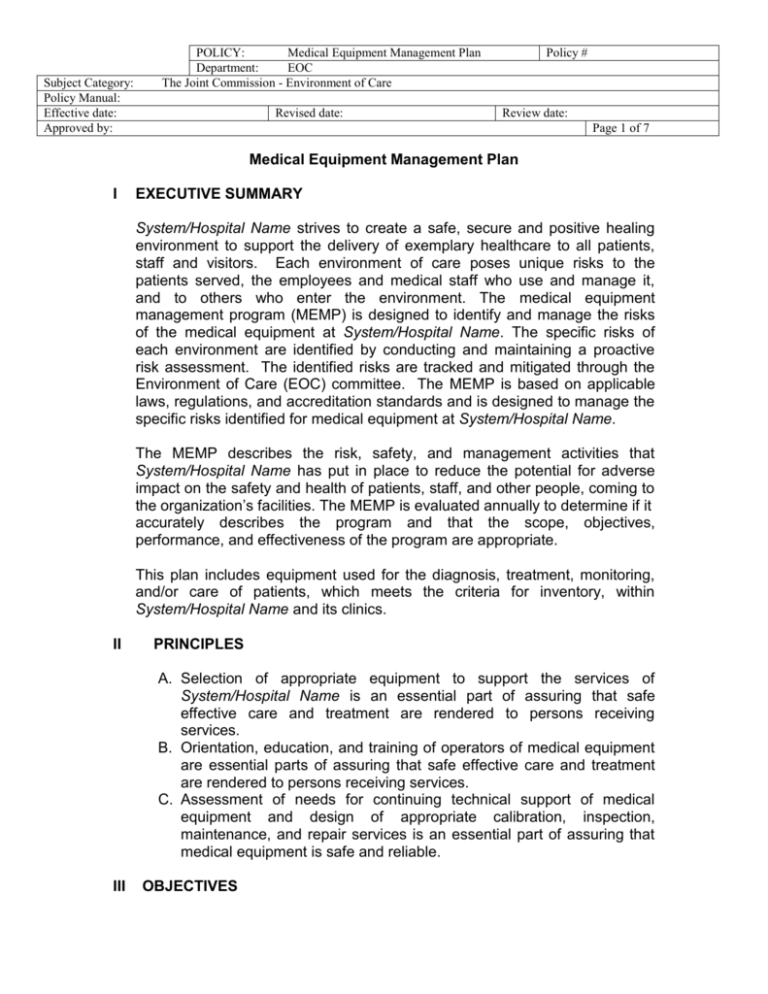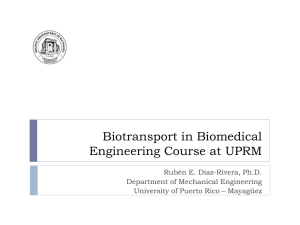Medical Equipment Management Plan
advertisement

Subject Category: Policy Manual: Effective date: Approved by: POLICY: Medical Equipment Management Plan Department: EOC The Joint Commission - Environment of Care Revised date: Policy # Review date: Page 1 of 7 Medical Equipment Management Plan I EXECUTIVE SUMMARY System/Hospital Name strives to create a safe, secure and positive healing environment to support the delivery of exemplary healthcare to all patients, staff and visitors. Each environment of care poses unique risks to the patients served, the employees and medical staff who use and manage it, and to others who enter the environment. The medical equipment management program (MEMP) is designed to identify and manage the risks of the medical equipment at System/Hospital Name. The specific risks of each environment are identified by conducting and maintaining a proactive risk assessment. The identified risks are tracked and mitigated through the Environment of Care (EOC) committee. The MEMP is based on applicable laws, regulations, and accreditation standards and is designed to manage the specific risks identified for medical equipment at System/Hospital Name. The MEMP describes the risk, safety, and management activities that System/Hospital Name has put in place to reduce the potential for adverse impact on the safety and health of patients, staff, and other people, coming to the organization’s facilities. The MEMP is evaluated annually to determine if it accurately describes the program and that the scope, objectives, performance, and effectiveness of the program are appropriate. This plan includes equipment used for the diagnosis, treatment, monitoring, and/or care of patients, which meets the criteria for inventory, within System/Hospital Name and its clinics. II PRINCIPLES A. Selection of appropriate equipment to support the services of System/Hospital Name is an essential part of assuring that safe effective care and treatment are rendered to persons receiving services. B. Orientation, education, and training of operators of medical equipment are essential parts of assuring that safe effective care and treatment are rendered to persons receiving services. C. Assessment of needs for continuing technical support of medical equipment and design of appropriate calibration, inspection, maintenance, and repair services is an essential part of assuring that medical equipment is safe and reliable. III OBJECTIVES Subject Category: Policy Manual: Effective date: Approved by: POLICY: Medical Equipment Management Plan Department: EOC The Joint Commission - Environment of Care Revised date: Policy # Review date: Page 2 of 7 The purpose of the Medical Equipment Management Plan is to promote quality patient care services performed within the hospital and its clinics. The director of Biomedical Engineering will manage and facilitate the program to accomplish the following: A. Promote safe and effective use of System/Hospital Name’s medical equipment by staff and physicians. B. Ensure that medical equipment used to care for patients, at the hospital and its clinics, performs within accepted medical equipment standards. C. Ensure medical equipment used within the hospital and its clinics is maintained within specifications to ensure its safe operation and readiness for use when needed. D. Protect patients, visitors, employees and physicians in the use of medical equipment. E. To meet standards of accreditation as defined by the Joint Commission and other regulatory agencies. IV PROGRAM MANAGEMENT STRUCTURE A. The Board of System/Hospital Name receives regular reports of the activities of the MEMP from the Environment of Care Committee. The Board reviews the reports and, as appropriate, communicates concerns about identified issues back to the Environment of Care Committee. B. Biomedical Engineering assures that an appropriate medical equipment maintenance program is implemented. Biomedical Engineering also collaborates with the Safety Officer to develop reports of MEMP performance for presentation to the Environment of Care Committee on a routine basis. C. Biomedical Engineering schedules and/or completes all calibration, inspection, and maintenance activities required to assure safe reliable performance of medical equipment in a timely manner. D. Individual staff members are responsible for being familiar with the risks inherent in their work and present in their work environment. They are also responsible for implementing the appropriate organizational, departmental, and job related procedures and controls required to minimize the potential of adverse outcomes of care and workplace accidents. V ELEMENTS OF THE MEDICAL EQUIPMENT PROGRAM ME.EC.01.01.01.7 – Medical Equipment Management Plan Subject Category: Policy Manual: Effective date: Approved by: POLICY: Medical Equipment Management Plan Department: EOC The Joint Commission - Environment of Care Revised date: Policy # Review date: Page 3 of 7 The Medical Equipment Management Program is described in this management plan. The MEMP describes the procedures and controls in place to minimize the potential harm that any patients, staff, and other people coming to the facilities of System/Hospital Name might experience. ME.EC.02.04.01.1 - Selection and Acquisition of Equipment Biomedical Engineering assists, advises, and/or coordinates ad-hoc advisory group activities for product selection and standardization. This includes the pre-purchase evaluation of medical equipment involving nursing, technical and administrative personnel that helps in choosing safe, effective and serviceable medical equipment. Training requirements are identified at this time. The department manager is responsible for the coordination of all training of their staff . ME.EC.02.04.01.2 - Criteria and Inventory The Director of the Biomedical Engineering department is responsible for the development of criteria used to identify risks associated with medical equipment. The criteria are used to evaluate risks related to the function of medical equipment, physical risks related to the use of equipment, and any history of patient safety issues related to the use of the equipment. The Director of the Biomedical Engineering Department is responsible for assuring that all medical equipment is screened at the time of commissioning. The screening procedure is applied, as appropriate, to loaner equipment, demonstration equipment, and equipment owned by physicians or other qualified individuals that is used as part of the care or treatment of a patient in any service of System/Hospital Name. ME.EC.02.04.01.3 - Maintenance Strategies The Director of the Biomedical Technology Services uses manufacturer recommendations, applicable codes and standards, accreditation requirements, and local or hospital experience to determine the appropriate maintenance strategy for assuring safety and maximizing equipment availability and service life. The strategies may include predictive maintenance, reliability-centered maintenance, interval-based inspections, corrective maintenance, or metered maintenance to ensure reliable performance. Subject Category: Policy Manual: Effective date: Approved by: POLICY: Medical Equipment Management Plan Department: EOC The Joint Commission - Environment of Care Revised date: Policy # Review date: Page 4 of 7 ME.EC.02.04.01.4 - Inspection, Testing, and Maintenance Intervals The Director of the Biomedical Technology Services uses manufacturer recommendations, risk levels, and hospital experience to determine the appropriate maintenance intervals for assuring safety and maximizing equipment availability and service life. A computerized maintenance management system is used to schedule and track timely completion of scheduled maintenance and service activities. The Director of the Biomedical Technology Services is responsible for assuring that the rate of timely completion of scheduled maintenance and other service activities meets regulatory and accreditation requirements. ME.EC.02.04.01.5 – Management of Medical Equipment Hazard Notices and Recalls The Director of Biomedical Technology Services (or his designee) coordinates the management of medical equipment hazard notices and recalls. The steps in the management process include: 1. Routing of all medical equipment hazard and recall notices to the responsible Biomedical Technology Services staff. 2. Logging of all hazard and recall notices determined to apply to equipment in use or storage in any location operated by Baylor University Medical Center Facilities. 3. Generation and circulation of an internal hazard and recall notice tracking sheet to all appropriate Biomedical Technology Services staff with instructions addressing how to respond to the hazard or recall notice. 4. Tracking of circulated notices to assure timely completion of activities required to eliminate or manage the issues addressed by the hazard or recall notice. 5. As appropriate, routine reports of any actions taken to address published hazard and recall notices related to medical equipment. The Risk Management Coordinator and the Director of Biomedical Technology Services are responsible for the Safe Medical Devices Act Subject Category: Policy Manual: Effective date: Approved by: POLICY: Medical Equipment Management Plan Department: EOC The Joint Commission - Environment of Care Revised date: Policy # Review date: Page 5 of 7 (SMDA) Reporting process. Information about reportable events is processed through the incident reporting process. Internally, the Risk Manager applies the Root Cause Analysis (RCA) process to all SMDA events. The findings of the RCA are used to update or develop procedures and controls, make changes in the environment, or provide additional education and training to eliminate or reduce the risks that led to the reportable event. ME.EC.02.04.01.6 - Emergency Procedures The Biomedical Technology Services staff and appropriate clinical care givers collaborate to identify the appropriate amount of back-up equipment during the evaluation/selection process of choosing the medical equipment. In the event of a medical equipment failure: A. The clinical department personnel will take appropriate clinical intervention until replacement equipment is available or the medical equipment is repaired. B. The clinical department will contact Biomedical Technology Services to see if back-up equipment is available. If equipment is not available, contact Supply Chain Management for help. C. The clinical department will contact Biomedical Technology Services at 214-820-4646 for repair of medical equipment. ME.EC.02.04.03 – Medical equipment is maintained, tested, and inspected ME.EC.02.04.03.1 - Equipment Inventory and Initial Testing Biomedical Technology Services maintains a current, accurate, and separate inventory of all equipment included in a program of planned inspection or maintenance. The inventory includes equipment owned by Baylor University Medical Center, leased and rented equipment, and personally owned equipment used for the diagnosis, treatment, and monitoring of patient care needs. The Director of Biomedical Technology Services assures effective implementation of the program of planned inspection and maintenance. All equipment in the program is tested for safety, operation and function prior to use on patients. Subject Category: Policy Manual: Effective date: Approved by: POLICY: Medical Equipment Management Plan Department: EOC The Joint Commission - Environment of Care Revised date: Policy # Review date: Page 6 of 7 ME.EC.04.02.03.2 - Testing of Life Support Equipment The Director of Biomedical Technology Services assures that scheduled testing of all life support equipment is performed in a timely manner. Reports of the completion rate of scheduled inspection and maintenance are presented to the Environment of Care Committee each quarter. If the quarterly rate of completion falls below 100%, the manager of the MEMP will also present an analysis to determine what the cause of the problem is and make recommendations for addressing it. ME.EC.04.02.03.3 - Testing of Non-Life Support Equipment The Director of Biomedical Technology Services assures that scheduled testing of all non-life support equipment is performed in a timely manner. Reports of the completion rate of scheduled inspection and maintenance are presented to the Environment of Care Committee each quarter. If the quarterly rate of completion falls below 90%, the manager of the MEMP will also present an analysis to determine what the cause of the problem is and make recommendations for addressing it. ME.EC.04.04.03.4 - Testing of Sterilizers The Sterile Processing staff is responsible for daily load testing and Biomedical Technology Services is responsible for maintenance of all types of sterilizers used at Baylor University Medical Center. Records of load testing are maintained by Sterile Processing and regular maintenance records are maintained by Biomedical Technology Services. Load testing results are reported to the Environment of Care Committee for evaluation and action. ME.EC.02.04.03.5 - Testing of Dialysis Water Systems Biomedical Technology Services is responsible for maintenance of dialysis equipment used in Baylor University Medical Center. The program of maintenance includes regular cleaning and disinfection of all dialysis equipment and testing for compliance with biological and chemical standards for the dialysis water supply. Water and Power Technologies performs regular maintenance and testing of the dialysis water supply. Dialysis department staff performs daily tests for purity of the water used for dialysis and out of range results are documented as patient safety incidents and reported to the Risk Manager for evaluation and action. Any event resulting in a patient injury or death will be treated as a Sentinel Event. Subject Category: Policy Manual: Effective date: Approved by: POLICY: Medical Equipment Management Plan Department: EOC The Joint Commission - Environment of Care Revised date: Policy # Review date: Page 7 of 7








